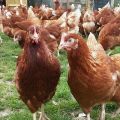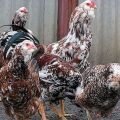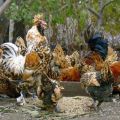What to do if the roosters fight among themselves and how to prevent aggression
Those who have chickens at the head of several roosters often face the aggressive behavior of their leaders. Violent males cause a lot of problems to the owner, because by this they disturb the order in the house and make the laying hens nervous, lowering their egg production. It is important to understand the situation, why the roosters fight among themselves, what to do with it and how not to harm the bird family.
Reasons for fights of roosters
Roosters have a natural duty to protect their chickens from competitors and various predators. The number of females that must be with him to ensure feeding and fertilization depends on the strength of the rooster. If there are two or more males in the hen house, fights between them are inevitable in order to establish the hierarchical stability of the flock. They begin to find out the relationship from the age of nine weeks.
Why roosters start fighting and attacking each other depends on different reasons:
- The male was acquired as a teenager or later in adulthood. He cannot accept the fact of master's authority, since his character has already been formed.
- A fight between an old and a young rooster in order to establish a new hierarchy. A young rooster is a stranger to the flock, and the old one will defend its territory, sometimes violently and bloody.
- Competition between young cocks trying to take the place of the dominant leader in the flock.
- An imprint on the character of one of the males can impose the past negative attitude of the owner or other chickens towards him, as a result of which the rooster has grown up hostile against others.
- The cramped conditions in the hen house force the birds to survive each other due to the resulting stress.
- The ratio of males to hens has not been calculated: there are too many males in the flock.
- Aggressive behavior intensifies in the spring when mating processes are activated.
Fighting between roosters is problematic for the bird owner, as it distracts males from what is most important: the covering of the hens. During fights, chickens eat poorly, experience stress, less often lay eggs, lose weight.

What to do if roosters fight among themselves
There are many ways to try to reconcile restless roosters. Providing the necessary conditions in the hen house, over time, it will be possible to achieve healthy competition, productive males and full-fledged defenders.
Insulation
Young roosters that have recently entered the flock often become aggressive.Their place has not yet been determined, and they become the subject of attack by strong individuals. As a result, a young male can become aggressive himself and attack anyone he considers dangerous to himself. Isolation will help solve the problem - the owner allocates a separate aviary or chicken coop for the rebel to minimize meetings between feuding roosters.
It is not recommended to let him go for a general walk until the aggressor stops acting wary.
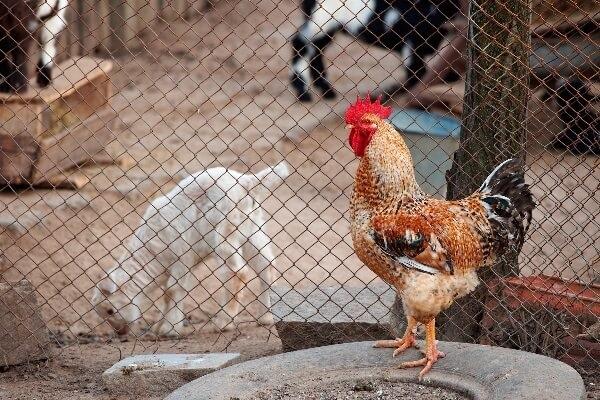
Hunger strike
A hungry diet will help teach a fighter a lesson. Having isolated him immediately after the attack, it is necessary to leave only clean water and not visit the bird for two days. So, the cockerel will not die of dehydration, and will think about his behavior. Since chickens have episodic memory, this allows the owner to play the role of a savior. After 2 days, entering the aviary and feeding the rooster, you can see that he is glad to meet you and has become more flexible.
Beak deflection
Debiking or trimming the beak will help protect weaker individuals from the attack of aggressive feathered pets. Inexperienced poultry farmers consider this method unnecessarily cruel, but the cut off tip of the beak does not prevent the rooster from eating and drinking in the future. At the same time, the roosters stop pecking at calm birds. One of the most common de-picking methods is using hot blades. Laser cutting is also used, but much less often due to the high cost. Beak trimming in adulthood should be carried out only as a last resort and with the assistance of an experienced specialist.

Eliminate annoying factors
Cases of aggressive behavior of males due to irritating factors are possible. It is necessary to pay attention to the moment at which the male's mood changes, what provokes him. It can be bright clothes or sudden movements. Sometimes small children show aggression towards chickens, and then roosters towards their relatives.
Having carefully followed the behavior of the feathered, one can understand what he reacts to so sharply and exclude the reasons for provoking aggression.
Mirror
By installing a mirror in the hen house, the owner will provide the bully of a new “enemy” in the person of himself. The feathered one will begin to fight with the reflection, forgetting about other opponents. This method has 2 significant drawbacks: the rooster can ignore the mirror or, conversely, injure himself too much.
Especially furious individuals can beat off their chest and head against the mirror.
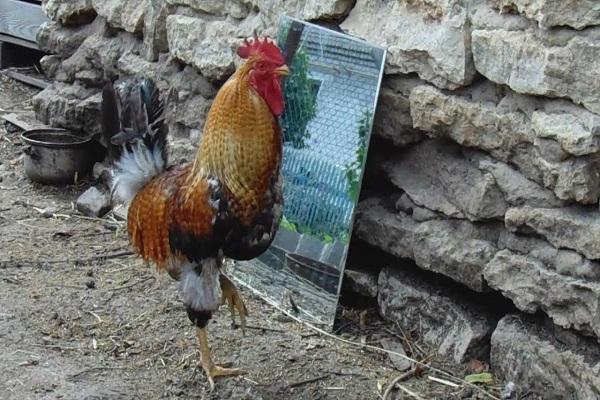
Paint
The main task of the rooster is to maintain order and discipline in the chicken coop. The presence of a bright color makes the leader more attractive. To give a bright color, natural dyes are usually used: brilliant green, henna, basma. They should be smeared with the most prominent places: wings, back, neck. So it will turn out to attract the attention of the hens and the rooster will not have time to sort things out with the rival.
Special glasses
The invention of the Chinese farmer Xiao Long was forced. He said that there were frequent fights between roosters on the farm, as a result of which up to 10 birds per day died. He concluded that birds see each other and for them this is a challenge. Glasses were invented in the form of a small plastic bracket that attaches to the beak. The eyes are closed with plates. The bird can eat and drink, but does not see an object to which aggression can be directed. Glasses are not a panacea, they only limit the uncontrollable situation. In a tight, confined space, birds have a heightened sense of touch; they can peck out feathers and down to each other by touch.
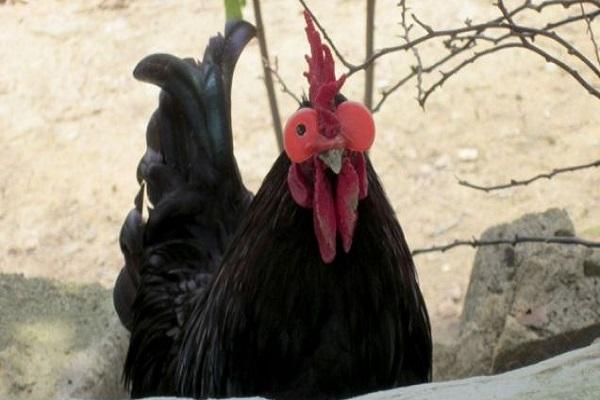
Dousing with water
Water education is tolerated only by strong, healthy individuals. The fact is that water procedures for birds are very stressful. The exception is some chickens who like to swim in the water of their own free will. In other cases, such upbringing can turn into a serious illness.
The method should be carried out immediately at the crime scene. As soon as the roosters start fighting, you need to catch the aggressor and dip him into a container of cold water, pour him out of a bucket or water him with a hose. The options are not fundamental, it is important to develop a reflex in the bird. As soon as the rooster enters the fight, the educational procedure is immediately repeated. Usually 5-7 repetitions of water dousing is enough to correct the temper of the troublemaker.

Beat the cock
Physical punishment is an undesirable method and is used as a last resort when no other intervention helps. Animal rights activists oppose this method of punishment, arguing it by violence against our smaller brothers. Experienced bird owners, on the contrary, consider this method effective, since it communicates information to the raging male in an accessible way.
To regulate the reflex, the rooster should be punished immediately after attacking another. In this case, it is important to calculate the strength so as not to harm the bird.
Decreased status in front of chickens
The bird world lives by its own rules. In roosters, the one who attacks first is considered the most powerful opponent. If the owner enters the chicken coop and attacks the rooster first, he will try to flee. The instinct of self-preservation in all living beings is in the first place. Periodically recalling who is in charge of the hen house, the owner will be able to lower the rooster's status in front of the hens and soften his aggression, turning it into fear of a stronger rival.
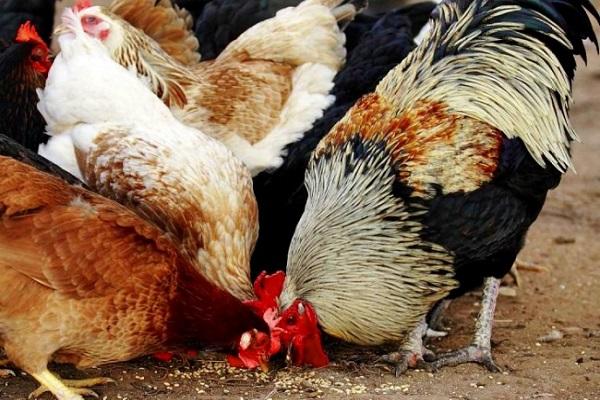
Prevention of aggression
In order to prevent fights between roosters, you must follow the rules:
- The number of males should be optimal: for 1 rooster up to 12-16 hens.
- Provide the territory of the chicken coop with drinking bowls and feeders. Having divided into groups, the chickens will not divide the area and there will be fewer fights.
- If there are a lot of roosters in one chicken coop, you can put an inclined ladder in the middle. To avoid a fight, weak individuals will run upstairs.
- It is worth monitoring the diet and diet of birds. A balanced menu, mixed feed and vitamins are an excellent prevention of stress in chickens.
- The behavior of birds depends on the lighting inside the hen house: it should not be too bright or, conversely, too dim.
Prevention of aggression in males does not always depend on the owner. Often genetics affects the behavior of birds. There are breeds in which aggressive males are more common than others. When purchasing an adult, you need to make sure whether there have been attempts to display aggression in the past.
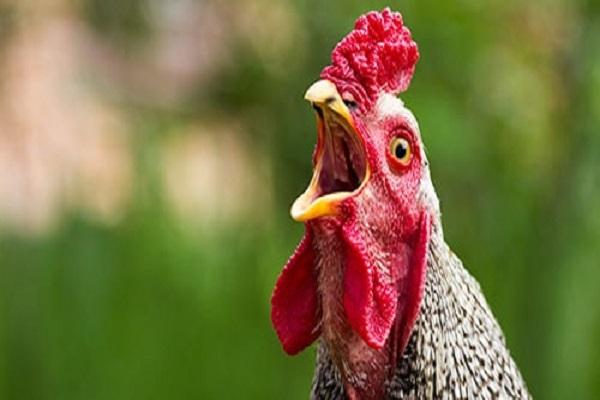
Why do chickens peck each other
Fights between females are no exception. Their behavior becomes aggressive for the following reasons:
- if there is no leader in the flock, then order and discipline are disturbed among the chickens;
- cramped chicken coop, no free range;
- incompatibility of rocks;
- a small number of feeders and drinkers;
- winter, when chickens are often in a dark room;
- establishing a hierarchy between young and old birds;
- stress when changing surroundings.
It is enough to establish living conditions or, if necessary, plant a male, then the behavior of the chickens will change.
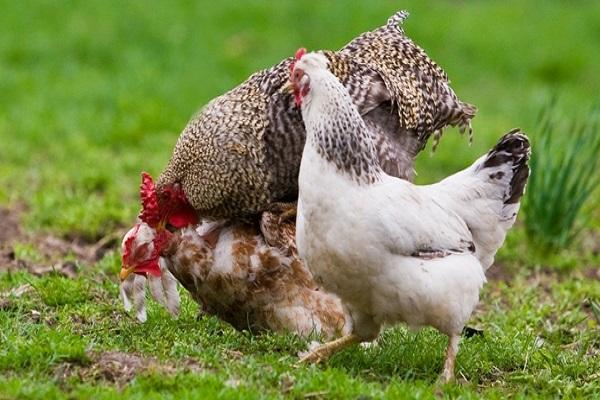
Preventive measures against pecking and cannibalism in chickens
The following changes in the content will help prevent pecking and cannibalism in chickens:
- check temperature and humidity in accordance with regulations;
- in hot dry weather, spray tap water on chickens;
- adjust the illumination (paint the bulbs red - this will calm the birds);
- provide uniform access to drinkers and feeders;
- if the number of heads is more than 30-40, you need to divide the walk or chicken coop;
- provide chickens with loose litter;
- Laying nests should be in shaded areas.
Farmers have found that by providing free range for the birds, the risk of biting or cannibalism is significantly reduced.





